
A lightvessel, or lightship, is a ship that acts as a lighthouse. They are used in waters that are too deep or otherwise unsuitable for lighthouse construction. Although some records exist of fire beacons being placed on ships in Roman times, the first modern lightvessel was located off the Nore sandbank at the mouth of the River Thames in London, England, and placed there by its inventor Robert Hamblin in 1734. Lightships have since become largely obsolete; some being replaced by lighthouses as construction techniques advanced, others by large automated navigation buoys.

United States lightship Chesapeake (LS-116/WAL-538/WLV-538) is a museum ship owned by the National Park Service and on a 25-year loan to Baltimore City, and is operated by Historic Ships in Baltimore Museum in Baltimore, Maryland. A National Historic Landmark, she is one of a small number of preserved lightships. Since 1820, several lightships have served at the Chesapeake lightship station and have been called Chesapeake. Lightships were initially lettered in the early 1800s, but then numbered as they were often moved from one light station to another. The name painted on the side of lightships was the short name of the Light Station they were assigned to and was the daytime visual aspect of the many Aids to Navigation on board lightships. The United States Coast Guard assigned new hull numbers to all lightships still in service in April 1950. After that date, Light Ship 116 was then known by the new Coast Guard Hull number: WAL-538. In January 1965 the Coast Guard further modified all lightship hull designations from WAL to WLV, so Chesapeake became WLV-538.

The United States Lighthouse Service, also known as the Bureau of Lighthouses, was the agency of the United States Government and the general lighthouse authority for the United States from the time of its creation in 1910 as the successor of the United States Lighthouse Board until 1939 when it was merged into the United States Coast Guard. It was responsible for the upkeep and maintenance of all lighthouses and lightvessels in the United States.
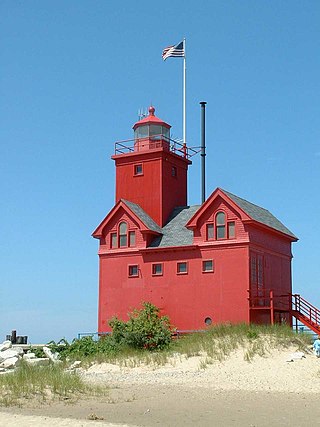
The Holland Harbor Light, known as Big Red, is located in Park Township, Michigan at the entrance of a channel connecting Lake Michigan with Lake Macatawa, and which gives access to the city of Holland, Michigan.

The Frankfort Light is a lighthouse located on the north breakwater in the harbor in Frankfort, Michigan. The current light was constructed in 1912 and placed on the National Register of Historic Places in 2005.
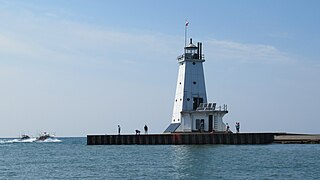
The Ludington Light is a 57-foot (17 m) tall steel-plated lighthouse in Ludington, Michigan, which lies along the eastern shores of Lake Michigan, at the end of the breakwater on the Pere Marquette Harbor. Given its location on the northern breakwater where the Pere Marquette River meets Lake Michigan, it is sometimes known as the Ludington North Breakwater Light. Underlying the building itself is a prow-like structure, which is designed to break waves.
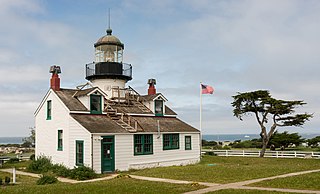
Point Pinos Lighthouse was lit on February 1, 1855, to guide ships on the Pacific Coast of California. It is the oldest continuously operating lighthouse on the West Coast of the United States and even the lens is original. Alcatraz Island Lighthouse preceded Point Pinos by eight months, but was replaced in 1909 by the expanding military prison. The Point Pinos Lighthouse is still an active United States Coast Guard aid to navigation. On-site museum exhibits and other lighthouse related functions are operated by the city of Pacific Grove, Monterey County, California. The lighthouse is surrounded by the Pacific Grove Municipal Golf Links.

The United States Lighthouse Board was the second agency of the U.S. federal government, under the Department of Treasury, responsible for the construction and maintenance of all lighthouses and navigation aids in the United States, between 1852 and 1910. The new agency was created following complaints of the shipping industry of the previous administration of lighthouses under the Treasury's Lighthouse Establishment, which had had jurisdiction since 1791, and since 1820, been under the control of Stephen Pleasonton.
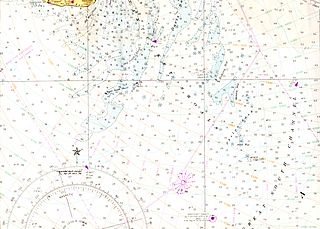
The station named Nantucket or Nantucket Shoals was served by a number of lightvessels that marked the hazardous Nantucket Shoals south of Nantucket Island. The vessels, given numbers as their "name," had the station name painted on their hulls when assigned to the station. Several ships have been assigned to the Nantucket Shoals lightship station and have been called Nantucket. It was common for a lightship to be reassigned and then have the new station name painted on the hull. The Nantucket station was a significant US lightship station for transatlantic voyages. Established in 1854, the station marked the limits of the dangerous Nantucket Shoals. She was the last lightship seen by vessels departing the United States, as well as the first beacon seen on approach. The position was 40 miles (64 km) southeast of Nantucket Island, the farthest lightship in North America, and experienced clockwise rotary tidal currents.
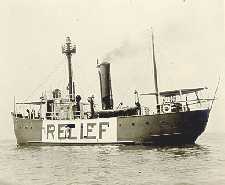
The United States lightship Huron (LV-103) is a lightvessel that was launched in 1920. She is now a museum ship moored in Pine Grove Park, Port Huron, St. Clair County, Michigan.
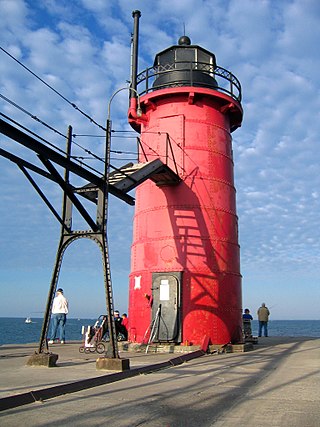
The South Haven South Pierhead Light is a lighthouse in Michigan, at the entrance to the Black River on Lake Michigan. The station was lit in 1872, and is still operational. The tower is a shortened version of the Muskegon South Pierhead Light, and replaced an 1872 wooden tower. The catwalk is original and still links the tower to shore: it is one of only four that survive in the State of Michigan.

Cape Mendocino Light was a navigation light at Cape Mendocino, California. The former lighthouse was relocated to Shelter Cove near Point Delgada, California in 1998, and the historic Fresnel lens to Ferndale, California, in 1948. An automated beacon operated for a number of years but was removed in May 2013.

The Ladies Delight Light is a small lighthouse on Lake Cobbosseecontee, in Winthrop, Maine, United States. It was constructed in 1908 and is believed to be the only active inland waters lighthouse in Maine. The tower is 25 feet (7.6 m) tall, and is equipped with a solar powered dual-level LED marine beacon. It operates every night of the year. At the time of its construction, it was the only inland lake lighthouse east of the Mississippi River. It was listed on the National Register of Historic Places in 1984.
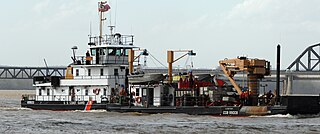
A buoy tender is a type of vessel used to maintain and replace navigational buoys. This term can also apply to an actual person who does this work.
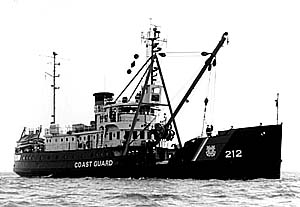
The United States Coast Guard Cutter Fir was the last lighthouse tender built specifically for the United States Lighthouse Service to resupply lighthouses and lightships, and to service buoys. Fir was built by the Moore Drydock Company in Oakland, California in 1939. On 22 March 1939, the U.S. Lighthouse Tender Fir was launched. She was steam driven with twin screws, 175 feet (53 m) in length, had a beam of 32 feet (9.8 m), drew 11 feet 3 inches (3.43 m) of water, and displaced 885 tons. Fir was fitted with a reinforced bow and stern, and an ice-belt at her water-line for icebreaking. She was built with classic lines and her spaces were lavishly appointed with mahogany, teak, and brass. The crew did intricate ropework throughout the ship. The cost to build Fir was approximately US$390,000. Fir's homeport was Seattle, Washington for all but one of her fifty one years of service when she was temporarily assigned to Long Beach, California when USCGC Walnut was decommissioned on 1 July 1982.

United States lightship Nantucket (LV-112) is a National Historic Landmark lightship that served at the Lightship Nantucket position. She was the last serving lightship and at time of its application as a landmark, one of only two capable of moving under their own power. She served as the lightship for such notable vessels as the liners United States, Queen Mary, and Normandie.

USCGC Fir (WLB-213) is a Juniper-class cutter of the United States Coast Guard. USCGC Fir is under the Operational Control (OPCON) of the Commander of the Seventeenth Coast Guard District and is homeported in Cordova, Alaska. Fir's primary mission is to service and maintain 132 aids to navigation around the Gulf of Alaska. The buoys USCGC Fir maintains are essential to commercial vessel traffic in major shipping ports of the Prince William Sound such as Valdez, Cordova, as well as across the Gulf of Alaska in Yakutat. USCGC Fir conducts heavy lift aids to navigation operations, law enforcement and other missions as directed.
The Nantucket Lightship LV58 was a lightvessel of the United States Lighthouse Board from 1894 to 1905. During those years, she primarily served the coast of Fire Island in New York and the Nantucket Shoals, though she was a relief vessel and served as needed in other locations off the northeast coast as well. From 1898 to her sinking in 1905, she was occasionally used as a lighthouse tender.
The USLHT Holly was one of two Holly-class side wheel bay and sound tenders built in 1881 for service in the Chesapeake Bay region, the other being USLHT Jessamine. Both ships in the class had composite hulls, with wood frames and iron sheathing, and were built by Malster & Reaney of Baltimore, Maryland. The original contract cost was estimated at $37,500 each. However, their actual cost upon completion was $41,911 each. The two ships replaced the lighthouse tenders Heliotrope and Tulip.




















